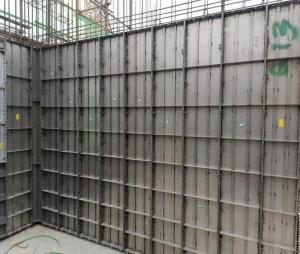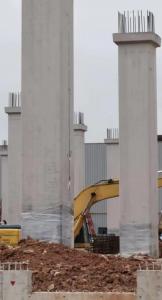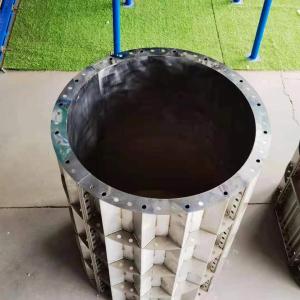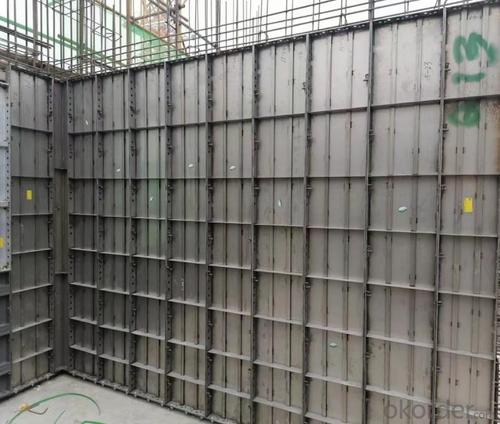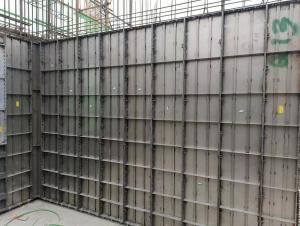Best qaulity of wall steel formwork, Stainless Steel Formwork,formwork for concrete walls
- Loading Port:
- Shanghai
- Payment Terms:
- TT or LC
- Min Order Qty:
- 1 set
- Supply Capability:
- 1000000 set/month
OKorder Service Pledge
OKorder Financial Service
You Might Also Like
Stainless steel formwork
Replaceable size aluminum formwork:400X1200mm , 400X1500mm
FORMWORK FOR building PROJECTS
Composition:
Painted steel frame with 3,5mm profiles
5mm stainless steel sheeting
Sheets welded from behind
Specifications :
Modular panel formwork
Panel thickness 12cm
Extremely strong and rigid
Fully compatible with the MF-80 system
Large size panels
Limited number of parts
High pressure resistance, minimum 100kN/m²
Long life expectancy
Stainless although magnetic sheets
Advantages:
1 Stainless steel formwork, 100% follow the design of aluminum alloy formwork system, it is interchangeable, compatible and can be used together with aluminum formwork at the same time .
2It is made of high-strength stainless steel strip by rolling and laser welding. It has good corrosion resistance and high density,is not easy to rust and has no fire hazard.
3Long service life, many turnover times, high recycling value
The number of turnovers is large, especially the characteristics of no dust, no need to brush or less mold release agent, and the characteristics of low renovation costs will bring unlimited optimistic prospects to it.
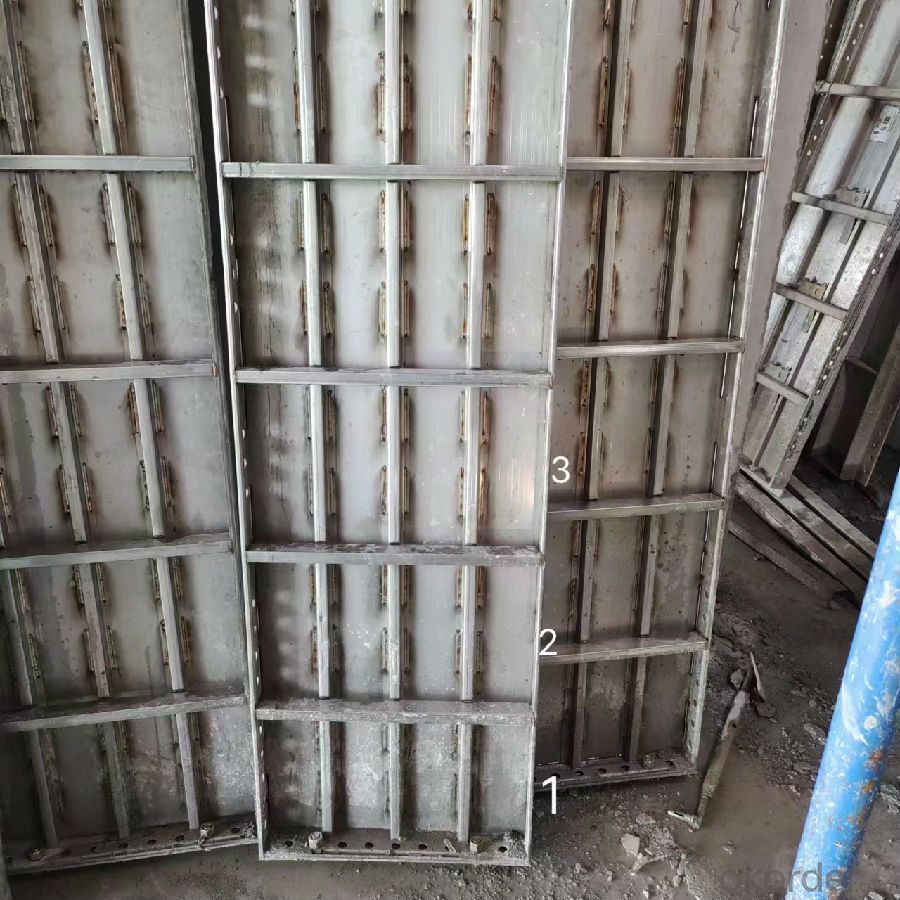
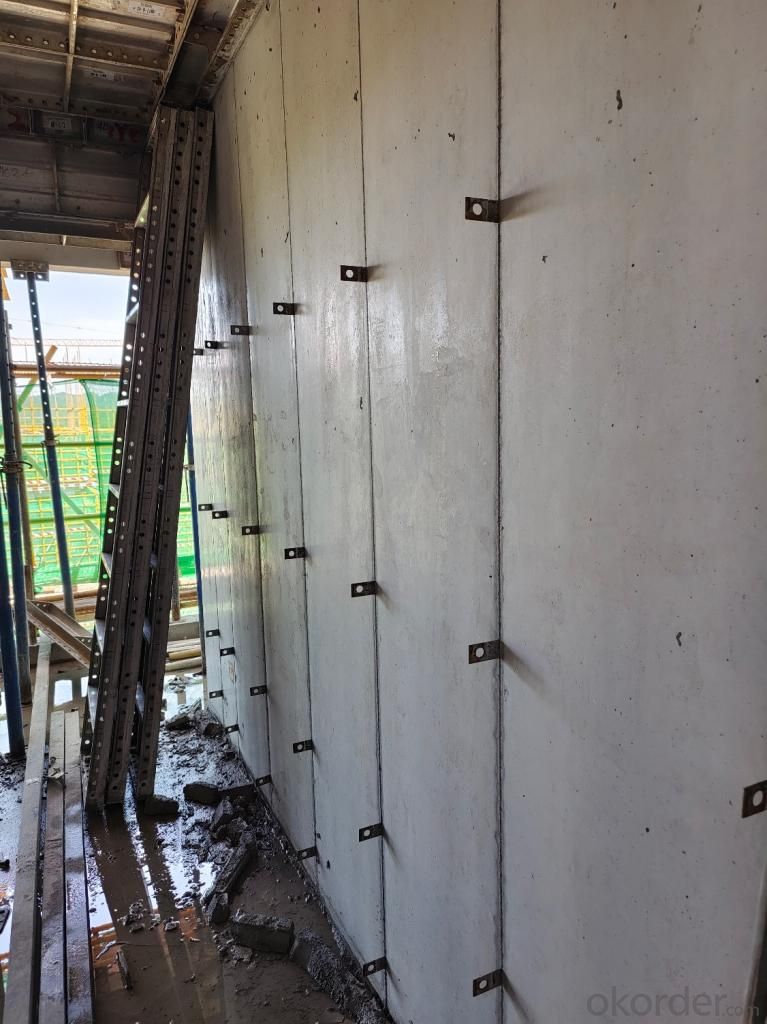
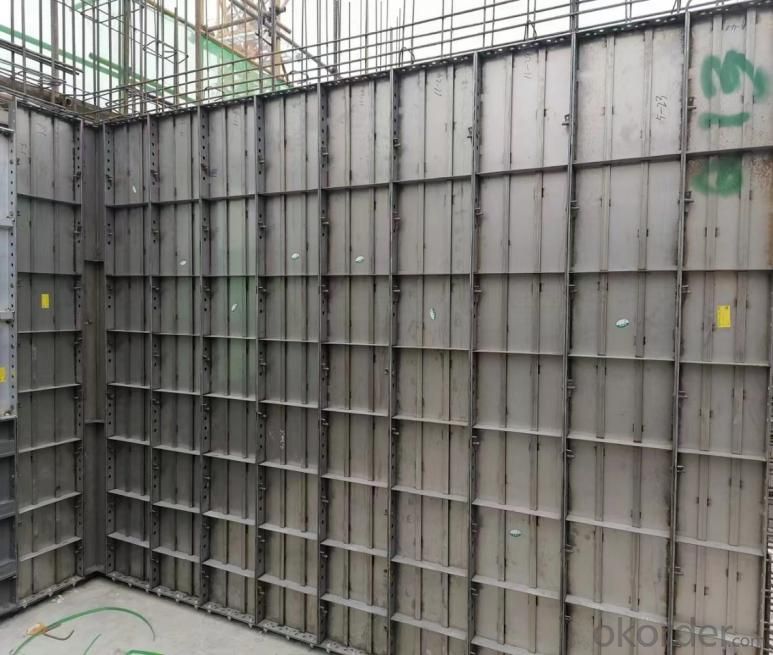
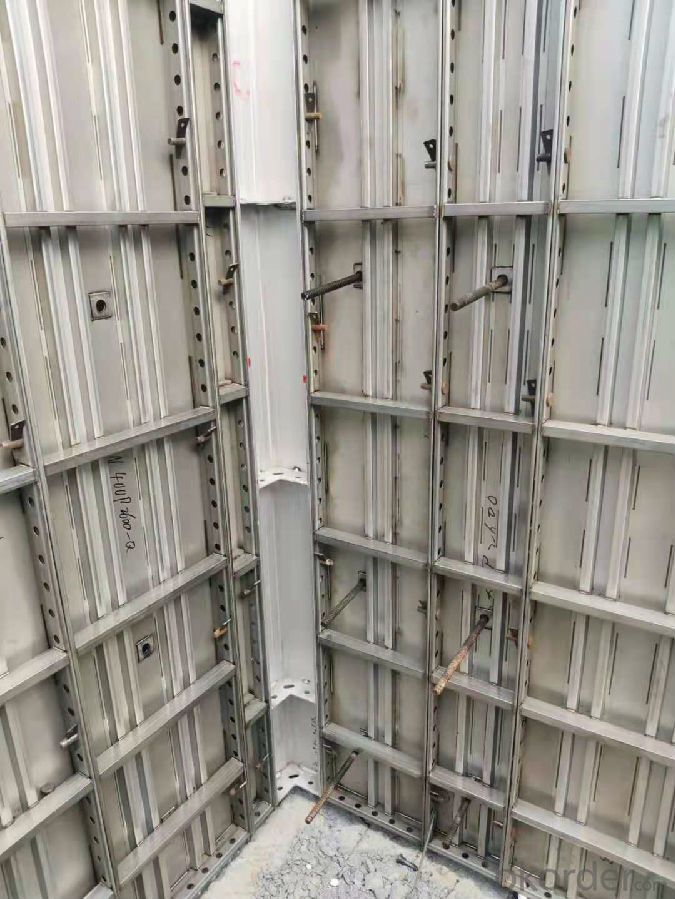
- Q: Is steel formwork more expensive than other types of formwork?
- Yes, steel formwork is generally more expensive than other types of formwork. Steel is a durable and strong material, making it a preferred choice for construction projects. However, its higher cost compared to alternatives such as wood or plastic formwork can be attributed to the higher manufacturing and material costs associated with steel.
- Q: How does steel formwork prevent concrete shrinkage and cracking?
- Steel formwork helps prevent concrete shrinkage and cracking by providing strong and rigid support during the curing process. When concrete is poured into the steel formwork, it takes the shape of the structure being built and hardens over time. The steel formwork acts as a mold, holding the concrete in place and preventing it from shrinking or cracking as it dries. One of the main causes of concrete shrinkage and cracking is the loss of moisture during the curing process. As the water in the concrete evaporates, it causes the material to shrink. This shrinkage can lead to cracks forming in the concrete if it is not properly supported. Steel formwork helps prevent this shrinkage by providing a tight and secure enclosure for the concrete. It ensures that the concrete retains its moisture and does not dry out too quickly. This slow and controlled drying process allows the concrete to cure evenly and reduces the likelihood of shrinkage and cracking. Additionally, steel formwork provides stability and support to the concrete, preventing it from moving or shifting as it hardens. This stability helps to distribute the forces and stresses evenly, reducing the risk of cracking or structural failure. Furthermore, the smooth and rigid surface of steel formwork helps to achieve a high-quality finish on the concrete. This prevents any irregularities or imperfections that may weaken the structure or make it more susceptible to cracking. In summary, steel formwork plays a crucial role in preventing concrete shrinkage and cracking by providing support, stability, and moisture retention during the curing process. Its strong and rigid structure ensures that the concrete remains intact and achieves a high-quality finish, reducing the risk of structural issues and enhancing the durability of the construction.
- Q: How does steel formwork affect the overall strength of the structure?
- Steel formwork can greatly affect the overall strength of a structure in a positive way. Steel is known for its exceptional strength and durability, making it an ideal material for formwork. When used in construction, steel formwork provides a rigid framework that supports the weight of the concrete during the pouring and curing process. The use of steel formwork ensures that the concrete is properly contained and supported, preventing any deformation or collapse during the hardening phase. This is crucial for maintaining the structural integrity of the building, as any failure in the formwork can lead to serious consequences. Steel formwork also allows for greater flexibility in design, as it can be easily customized and shaped according to the desired structure. This versatility enables engineers and architects to create complex and innovative designs without compromising the strength of the building. Moreover, steel formwork has a longer lifespan compared to other types of formwork materials, such as wood or plastic. Its durability ensures that the formwork can be reused multiple times, reducing construction costs and minimizing waste. This not only makes it cost-effective but also contributes to sustainability in the construction industry. In summary, steel formwork positively impacts the overall strength of a structure by providing a robust and reliable support system for the concrete. Its strength, durability, and flexibility make it an excellent choice for ensuring the structural integrity and longevity of buildings.
- Q: Can steel formwork be used for underground construction projects?
- Underground construction projects can indeed utilize steel formwork. Steel formwork proves to be a versatile and enduring option for erecting different types of structures, even those situated below ground level. It offers a robust and firm support system capable of withstanding the pressures and loads associated with underground construction. When it comes to constructing underground projects like tunnels, basements, or subways, steel formwork presents several advantages. Firstly, it boasts a high load-bearing capacity and structural integrity, making it suitable for enduring the weight and pressure exerted by the surrounding soil or water. This ensures the safety and stability of the structure being erected. Furthermore, steel formwork exhibits resistance to corrosion, a crucial attribute in underground construction where exposure to water, humidity, and other corrosive elements is prevalent. This corrosion resistance guarantees the longevity and durability of the formwork, minimizing maintenance needs and extending the lifespan of the structure. Moreover, steel formwork offers design flexibility and can be easily tailored to meet specific project requirements. It can be fabricated into various shapes and sizes, enabling the construction of intricate underground structures. The modular nature of steel formwork also facilitates effortless assembly, disassembly, and reusability, proving advantageous for projects that necessitate frequent formwork repositioning. In conclusion, steel formwork proves to be a suitable choice for underground construction projects due to its strength, durability, corrosion resistance, and design flexibility. It provides a dependable and efficient solution for erecting underground structures, ensuring their safety and longevity.
- Q: Are there any limitations or disadvantages of using steel formwork?
- Yes, there are some limitations and disadvantages of using steel formwork. Firstly, steel formwork is generally more expensive compared to other types of formwork materials such as wood or plastic. This can make it less cost-effective, especially for smaller construction projects. Secondly, steel formwork is heavier and less flexible than other materials, making it more difficult to transport and handle on site. This can lead to longer construction times and increased labor costs. Additionally, steel formwork requires skilled labor and expertise to assemble and dismantle properly. If not done correctly, it can lead to inaccuracies in the final concrete structure, affecting the overall quality of the construction. Lastly, steel formwork is prone to corrosion, especially in high-moisture environments. Regular maintenance and protective coatings are necessary to prevent rust and ensure the longevity of the formwork.
- Q: Can steel formwork be used for both manual and mechanical concrete pouring?
- Indeed, both manual and mechanical concrete pouring can utilize steel formwork. Renowned for its robustness and sturdiness, steel formwork is apt for handling the immense pressure and weight of concrete, regardless of the pouring method employed. It furnishes a steadfast and inflexible framework that endures the strains exerted during the pouring and setting of concrete. Moreover, steel formwork is adaptable and can be effortlessly modified or reconstructed to accommodate diverse configurations and dimensions of concrete structures. Consequently, it is frequently employed in construction ventures that employ both manual and mechanical concrete pouring techniques.
- Q: Concrete, reinforcing steel for the labor price? 18 storey elevator apartment with a layer of underground carpentry, concrete, steel artificial price. (to the workers to do the Contractor) the problem added: steel, including the production and installation of a full set of artificial ha, concrete is mixed business. Template carpenter??? Concrete with nails??? Steel??? Including machine...Is the area of 10000 square meters of construction area template?How many tons of steel?
- The main body of the wall and inside and outside the powder to the construction area of 70/M2 (including small equipment)10000 square meters of construction area by the consideration of the template to pay two, the need for a template of 10000 square metersThere are about 6~700 tons of rebar
- Q: What is the expected lifespan of steel formwork ties?
- The expected lifespan of steel formwork ties can vary depending on various factors such as the quality of the steel used, the conditions in which they are used, and the maintenance and care provided. However, on average, steel formwork ties can last for several years, typically ranging from 5 to 10 years or even longer if properly maintained.
- Q: Can steel formwork be used for precast concrete beams with complex geometries?
- Yes, steel formwork can be used for precast concrete beams with complex geometries. Steel formwork offers numerous advantages for creating complex shapes and designs in precast concrete beams. Steel is a strong and durable material that can withstand the pressures and forces exerted during the concrete pouring and curing process. It can be easily fabricated to create the desired shape and size of the beam, making it suitable for complex geometries. Steel formwork also provides excellent dimensional accuracy, ensuring that the precast concrete beams maintain their intended shape and dimensions. This is particularly important for beams with complex geometries, as any slight variation in shape could affect their structural integrity. Additionally, steel formwork offers a smooth and high-quality finish to the concrete surface. This is essential for beams with complex geometries, as a smooth surface ensures proper load distribution and reduces the risk of cracking or other structural issues. Furthermore, steel formwork can be reused multiple times, making it a cost-effective option for creating precast concrete beams with complex geometries. The versatility and durability of steel formwork make it a preferred choice for many construction projects, including those involving complex precast concrete beams. In conclusion, steel formwork is a suitable and practical choice for creating precast concrete beams with complex geometries. Its strength, durability, dimensional accuracy, and smooth finish make it an ideal solution for achieving the desired shape and design in these beams.
- Q: Can steel formwork be used for airport runway construction?
- Airport runways can indeed be constructed using steel formwork. Steel formwork is a versatile and durable option for building concrete structures, including runways. It offers numerous advantages compared to other forms of formwork, such as timber or aluminum. To begin with, steel formwork provides a high level of strength and stability, ensuring an efficient and accurate concrete pouring process. This is crucial in runway construction, as the surface must be even and strong enough to withstand heavy aircraft traffic. Additionally, steel formwork is reusable, making it cost-effective for large-scale projects like airport runways. Its durability allows for multiple uses, reducing the need for frequent replacements and saving both time and money. Moreover, steel formwork can be easily assembled and disassembled, making it convenient for construction sites with tight schedules or limited space. Its modular design allows for quick installation and adjustment, enabling efficient construction progress. Furthermore, steel formwork exhibits excellent resistance to various weather conditions, including extreme temperatures and moisture. This is vital for airport runways, which endure constant wear and tear from aircraft as well as harsh weather conditions. In conclusion, steel formwork is a suitable choice for airport runway construction due to its strength, reusability, ease of use, and resistance to different weather conditions. Its ability to provide a stable and durable surface makes it an ideal option for creating runways capable of handling heavy aircraft traffic.
Send your message to us
Best qaulity of wall steel formwork, Stainless Steel Formwork,formwork for concrete walls
- Loading Port:
- Shanghai
- Payment Terms:
- TT or LC
- Min Order Qty:
- 1 set
- Supply Capability:
- 1000000 set/month
OKorder Service Pledge
OKorder Financial Service
Similar products
Hot products
Hot Searches
Related keywords
